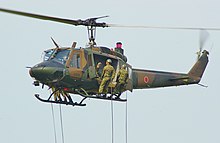Army aviation
This articleneeds additional citations forverification.(January 2017) |

Anarmy aviationunit is anaviation-related unit of a nation'sarmy,sometimes described as anair corps.These units are generally separate from a nation's dedicatedair force,and usually comprisehelicoptersand light supportfixed-wing aircraft.Prior to the establishment of separate national air forces, many armies hadmilitary aviationunits, which as the importance of aviation increased, were spun off into independent services. As the separation between a nation's army and air force led to a divergence of priorities, many armies sought to re-establish their own aviation branches to best serve their own organic tactical needs.
History
[edit]Military aviationfirst began as either army ornaval aviationunits established as force multipliers to allow armies and navies to better do what they were already doing, this taking mostly the form ofreconnaissanceandartillery spotting,this led to the first fighter aircraft whose purpose was to shoot down enemy reconnaissance and artillery spotting aircraft, and to protect one's own aircraft from being shot down. At this point the purpose of aircraft was still to act as an adjunct to traditional armies and fleets operating in the traditional way. However, as aircraft became more technologically sophisticated military theorists of the interwar period began to think ofairpoweras a means in and of itself where the critical blow could be delivered bystrategic bombing,and the experience of World War II confirmed this. Post World War II air forces such as theRoyal Air Forceand the newly establishedUnited States Air Forceconcentrated on building strategic bomber forces for attack and fighter forces to defend against enemy bombers. Air forces still incorporated a significant amount oftactical missionsthroughair interdictionandclose air supportmissions.
In order to acquire a close air support capability armies sought to expand, establish or re-establish their own tactical aviation branches, which are usually composed of helicopters, rather than fixed-wing aircraft.
With the development ofunmanned aerial vehiclessome armies have begun to use smallbattlefield UAVs,not attached to army aviation units, but rather directly attached to artillery battalions as spotters, and with the smallest and lightest drones being deployed by individual infantry platoons to provide real time local reconnaissance.
Tasks
[edit]
The tasks of each army's aviation units are defined slightly different, depending on country. Some general characteristics include:
- Tactical offensive action (anti-tank warfare,air assault,andclose air support)[1]
- ISTAR(Intelligence,Surveillance,Target acquisition,Reconnaissance)[1]
- Logistic and battlefield support
- Tactical transportboth internally and externally, of personnel and material
- Search and rescue
- Medical evacuation
- Liaison
- Disaster relief
Equipment
[edit]
In order to fulfill their manifold tasks, army aviation mostly uses helicopters. These helicopters can be classified into the following categories:
- Attack helicoptersfor close air support of ground troops andanti-tankrole
- Transport helicopters
- Observation helicopters
- Utility helicopters
- Combat Search and Rescue(CSAR),Casualty evacuation(CASEVAC) /Medical evacuation(MEDEVAC) helicopters
- Training helicopters
In addition to helicopters, some armies also operate fixed-wing aircraft for tactical reconnaissance.
List of army aviation units
[edit]
- Argentine Army Aviation(Argentine Army)
- Army Air Corps (United Kingdom)(British Army)
- Army Aviation Corps (India)(Indian Army)
- Australian Army Aviation(Australian Army)
- Bangladesh Army Aviation Group(Bangladesh Army)
- Brazilian Army Aviation Command(Brazilian Army)
- Colombian National Army Aviation(Colombian Army)
- People's liberation army ground air force(Chinese army)
- French Army Light Aviation(French Army)
- German Army Aviation Corps(German Army)
- Hellenic Army Aviation(Hellenic Army)
- Army Aviation Corps (India)
- Indonesian Army Aviation(Indonesian Army)
- Islamic Republic of Iran Army Aviation(Islamic Republic of Iran Army)
- Islamic Revolutionary Guard Corps Aviation (IR.SA)

An Argentine ArmyCessna T-41D trainer aircraft, in 2009 - Iraqi Army Aviation Command(Iraqi Army)
- Malaysian Army Aviation(Malaysian Army)
- Nepalese Army Air Service(Nepali Army)
- Pakistan Army Aviation Corps(Pakistan Army)
- Portuguese Army Light Aviation Unit(Portuguese Army)
- Spanish Army Airmobile Force(Spanish Army)
- Royal Thai Army Aviation Center(Royal Thai Army)
- Turkish Army Aviation Command(Turkish Army)
- Ukrainian Army Aviation(Ukrainian Ground Forces)
- United States Army Aviation Branch(U.S. Army)
See also
[edit]References
[edit]- ^ab"Army Aviation Role".British Army.Retrieved1 August2016.
Further reading
[edit]- Allen, Matthew (1993),Military helicopter doctrines of the major powers, 1945-1992. Making decisions about air-land warfare,Westport (CT): Greenwood,ISBN0-313-28522-5
- Gunston, Bill (1981),An illustrated guide to military helicopters,New York: Arco Publishing,ISBN0-668-05345-3
- Halberstadt, Hans (1990),Army Aviation,Novato (CA): Presidio,ISBN0-89141-251-4
- Sutton, John; Walker, John (1990),From horse to helicopter. Transporting the British Army in war and peace,London: Cooper,ISBN0-85052-724-4
- Warner, Guy; Boyd, Alex (2004),Army Aviation in Ulster,Newtownards, Co. Down: Colourpoint Books,ISBN1-904242-27-8
- Young, Ralph B. (2000),Army aviation in Vietnam. An illustrated history of unit insignia, aircraft camouflage and markings,Ramsey (NJ): Huey Co.,ISBN0-9671980-1-1
External links
[edit]![]() Media related toArmy aviationat Wikimedia Commons
Media related toArmy aviationat Wikimedia Commons
